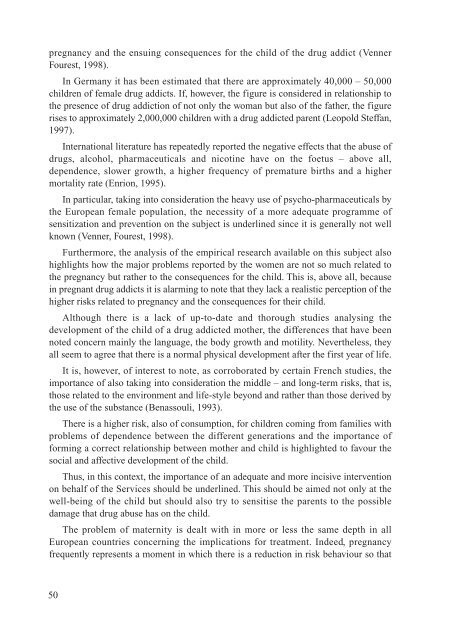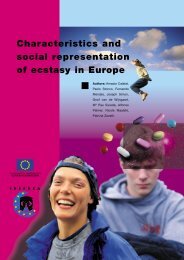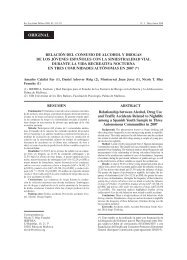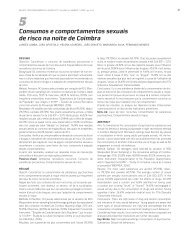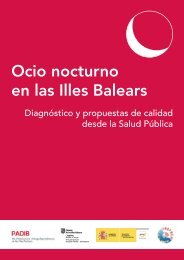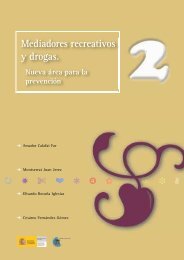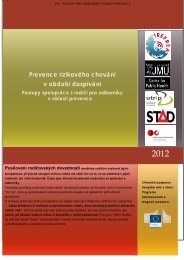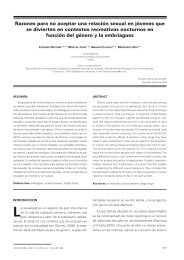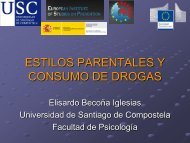It has also been noticed that it is perhaps the stereotype associated with the use ofcondoms as a clandest<strong>in</strong>e or sporadic sexual activity s<strong>in</strong>ce frequently female <strong>drug</strong>addicts use condoms when prostitut<strong>in</strong>g themselves but do not use the same precautionwhen with their <strong>drug</strong> addicted partner(s).However, prostitution, frequent <strong>in</strong> female <strong>drug</strong> addicts, represents another specificrisk factor both because it is often the ma<strong>in</strong> source of <strong>in</strong>come for the women and alsobecause it is a means to ma<strong>in</strong>ta<strong>in</strong> their <strong>drug</strong> addicted partner economically (Serre,1994).A specific aspect reported <strong>in</strong> the literature <strong>in</strong> an attempt to confirm the diversedevelopment of <strong>drug</strong> addicts accord<strong>in</strong>g to their sex is that of the problem of physicaland sexual violence and, <strong>in</strong> general, the distortion of the relationships with<strong>in</strong> theorig<strong>in</strong>al family, factors which are reported as true factors of specific risk (Malagoli,Togliatti, 1993).The characteristics of the multiple problems frequently found <strong>in</strong> the family arehighlighted. Frequently, <strong>in</strong> addition to the problems of <strong>drug</strong> addiction of a parent orbrother/sister, there is also violence and ill-treatment at home, very often at the hand ofthe father figure (Guasti Piovanelli, 1995).Furthermore, nearly all the countries that participated <strong>in</strong> the study reported anoticeable percentage of ill-treatment and sexual <strong>abuse</strong> <strong>in</strong> the case histories of many ofthe <strong>drug</strong> addicted women. The same factor does not seem to apply <strong>in</strong> relation to themale subjects.<strong>Europe</strong>an literature also reports a much higher percentage of suicide attemptsamongst the female <strong>drug</strong> addicts than amongst females of the same age <strong>in</strong> the generalpopulation (Coluccia, Traverso, Ferretti, 1997; Llopis, 1998).One very important detail <strong>in</strong> the comparison of gender is obviously that ofpregnancy and maternity which, not surpris<strong>in</strong>gly, revealed itself to be one of the mostdiscussed subjects <strong>in</strong> the literature of all countries. The depth of reflection, however,was not always satisfactory and it would be hoped that the subject will be dealt with <strong>in</strong>more detail.Tak<strong>in</strong>g <strong>in</strong>to consideration only the respective national health structures, the<strong>Europe</strong>an literature under exam<strong>in</strong>ation underl<strong>in</strong>ed the higher frequency of miscarriagesand abortions amongst female <strong>drug</strong> addicts when compared to the general population.Overall, any <strong>drug</strong> addict is considered to be at high risk, not only regard<strong>in</strong>g the healthof the mother but also that of the foetus (Amar, 1998).The problems related to maternity, whether gynaecological or obstetrical due to thepregnancy or to a desired pregnancy or to the child’s health, help sensitise the womanto problems of a sanitary or social typology more often than the man so that she seeksthe aid of these services more frequently.A bibliographic review has highlighted a specific <strong>in</strong>terest which was noticeable to agreater degree <strong>in</strong> the French contributions regard<strong>in</strong>g the cl<strong>in</strong>ical aspects related to49
pregnancy and the ensu<strong>in</strong>g consequences for the child of the <strong>drug</strong> addict (VennerFourest, 1998).In Germany it has been estimated that there are approximately 40,000 – 50,000children of female <strong>drug</strong> addicts. If, however, the figure is considered <strong>in</strong> relationship tothe presence of <strong>drug</strong> addiction of not only the woman but also of the father, the figurerises to approximately 2,000,000 children with a <strong>drug</strong> addicted parent (Leopold Steffan,1997).International literature has repeatedly reported the negative effects that the <strong>abuse</strong> of<strong>drug</strong>s, alcohol, pharmaceuticals and nicot<strong>in</strong>e have on the foetus – above all,dependence, slower growth, a higher frequency of premature births and a highermortality rate (Enrion, 1995).In particular, tak<strong>in</strong>g <strong>in</strong>to consideration the heavy use of psycho-pharmaceuticals bythe <strong>Europe</strong>an female population, the necessity of a more adequate programme ofsensitization and prevention on the subject is underl<strong>in</strong>ed s<strong>in</strong>ce it is generally not wellknown (Venner, Fourest, 1998).Furthermore, the analysis of the empirical research available on this subject alsohighlights how the major problems reported by the women are not so much related tothe pregnancy but rather to the consequences for the child. This is, above all, because<strong>in</strong> pregnant <strong>drug</strong> addicts it is alarm<strong>in</strong>g to note that they lack a realistic perception of thehigher risks related to pregnancy and the consequences for their child.Although there is a lack of up-to-date and thorough studies analys<strong>in</strong>g thedevelopment of the child of a <strong>drug</strong> addicted mother, the differences that have beennoted concern ma<strong>in</strong>ly the language, the body growth and motility. Nevertheless, theyall seem to agree that there is a normal physical development after the first year of life.It is, however, of <strong>in</strong>terest to note, as corroborated by certa<strong>in</strong> French studies, theimportance of also tak<strong>in</strong>g <strong>in</strong>to consideration the middle – and long-term risks, that is,those related to the environment and life-style beyond and rather than those derived bythe use of the substance (Benassouli, 1993).There is a higher risk, also of consumption, for children com<strong>in</strong>g from families withproblems of dependence between the different generations and the importance ofform<strong>in</strong>g a correct relationship between mother and child is highlighted to favour thesocial and affective development of the child.Thus, <strong>in</strong> this context, the importance of an adequate and more <strong>in</strong>cisive <strong>in</strong>terventionon behalf of the Services should be underl<strong>in</strong>ed. This should be aimed not only at thewell-be<strong>in</strong>g of the child but should also try to sensitise the parents to the possibledamage that <strong>drug</strong> <strong>abuse</strong> has on the child.The problem of maternity is dealt with <strong>in</strong> more or less the same depth <strong>in</strong> all<strong>Europe</strong>an countries concern<strong>in</strong>g the implications for treatment. Indeed, pregnancyfrequently represents a moment <strong>in</strong> which there is a reduction <strong>in</strong> risk behaviour so that50
- Page 1: Women drug abuse in Europe:gender i
- Page 5 and 6: © IREFREA & European CommissionI.S
- Page 7 and 8: ORGANIZATIONS AND NATIONAL RESEARCH
- Page 10 and 11: INDEXPagePreface(by P. Stocco, A. C
- Page 12 and 13: PREFACEThis book presents a series
- Page 14 and 15: female exposes herself to the risk
- Page 16 and 17: DRUG ADDICTION AND MATERNITYActive
- Page 18: devaluation of the daughter is ther
- Page 21 and 22: Europe, leads to the situation that
- Page 23 and 24: Accordingly, the study was construc
- Page 25 and 26: -Dimension of maternity-Legal dimen
- Page 28 and 29: CHAPTER 1WOMEN AND DRUG ABUSE. GENE
- Page 30 and 31: Thom 1995, Nelson-Zlupko et al, Ett
- Page 32 and 33: ole of double dependency so typical
- Page 34 and 35: problem. The use of benzodiazepines
- Page 36 and 37: THERAPYThe effectiveness of the dif
- Page 38: - Diagnostic criteria and treatment
- Page 41 and 42: The sphere of sexuality does not ap
- Page 43 and 44: ehaviour of intravenous drug addict
- Page 46 and 47: CHAPTER 3GENDER IDENTITY AND DRUG A
- Page 48 and 49: of female drug addiction with respe
- Page 52: even if this should not be neglecte
- Page 55 and 56: The analysis of specific experience
- Page 57 and 58: diploma and vice-versa a high perce
- Page 59 and 60: (11.7%), or due to indifference (10
- Page 61 and 62: drugs (9.1%). The same two typologi
- Page 63 and 64: month (overall with ample variation
- Page 65 and 66: out that the female sex is characte
- Page 67 and 68: the school as an institution with t
- Page 70 and 71: BEST PRACTICES(*)The aim of this pa
- Page 72 and 73: Intervention methods:Network struct
- Page 74 and 75: SPAIN1. Treatment centre for drug a
- Page 76 and 77: The PIS has four double rooms, two
- Page 78 and 79: 6. Comunidad terapéutica femeninaL
- Page 80 and 81: Network contacts:Close co-operation
- Page 82 and 83: For whom:Women with babies.Interven
- Page 84 and 85: 10. Programme for women with proble
- Page 86 and 87: tel.+49 30 6921782fax.+49 30 695061
- Page 88 and 89: 2. Programme for sero-positive drug
- Page 90 and 91: Team:7 social operators of which 2
- Page 92: Therapeutic approach: individual an
- Page 96 and 97: VADEMECUMOne of the main aims of th
- Page 98 and 99: An MMP is seen as contra-indicated
- Page 100 and 101:
11) Improving the activity of infor
- Page 102:
34) During pregnancy addicted women
- Page 106 and 107:
IREFREA:Drug-addiction and gender i
- Page 108 and 109:
9) If no, why? (multiple choices)1:
- Page 110 and 111:
19) What was the result? (multiple
- Page 112 and 113:
• Could you explain the reason of
- Page 114 and 115:
38) If your partner used to take dr
- Page 116 and 117:
5: danger of diseases ❒ 48.56: ba
- Page 118 and 119:
60) Present relationship: (only 1 a
- Page 120 and 121:
75) Which were your worries? (multi
- Page 122 and 123:
6: drug-addiction ❒ 86.67: prejud
- Page 124 and 125:
• How did doctors and the staff b
- Page 126 and 127:
LEGAL DIMENSION113) Have you actual
- Page 128 and 129:
• Have you ever felt discriminate
- Page 130 and 131:
137) How old were you when you real
- Page 132 and 133:
BIBLIOGRAPHYAgnoletto V., Cesarani
- Page 134 and 135:
Booth, R. et al. (1991) “Intraven
- Page 136 and 137:
Cuskey, W (1982) “Female Addictio
- Page 138 and 139:
Gatti U., Marugo M. I., Malfatti D.
- Page 140 and 141:
Lejeun-E C. (1997) “Prise en char
- Page 142 and 143:
Modonutti G.B. (1996) “ Modelli d
- Page 144 and 145:
Ravenna M. (1993) Adolescenti e dro
- Page 146 and 147:
Swift, W., Copeland, J. Y Hall, W.
- Page 150:
I R E F R E AIREFREA is a european


